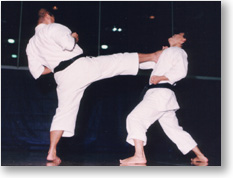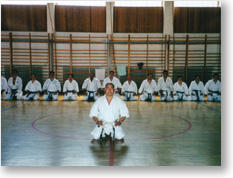|

Sensei Namiki demonstrating Mae Geri.
|
What is Karate?
The most commonly known benefit of Karate training is self-defense. However there are
many other benefits from training in Karate including:
- physical fitness, strength, flexibility, and endurance.
- develops self discipline, self-confidence, and self-esteem.
- teaches you to respect others as well as yourself.
- it improves your concentration.
True traditional karate is a martial (i.e. combat) art. It is not a sport (although some have
unfortunately given karate that image). The essence of karate is not in breaking wood or
performing flying kicks or loud screams. Neither is it a religion. In its most basic form it is
concerned with developing a realistic method of self defence that ensures an attacker is
effectively disabled.

Black Belt class, conducted by Namiki Sensei, meditating (mokusoh).
|
This is not a skill that is acquired overnight, or even after weeks or
months. There is no magic formula. It involves years of hard hard work, dedication and
perseverance and is very much a test of character as anything else. Gradually, over time, you will
improve your skills, reflexes and techniques as you develop within the art.
Because it is more straightforward and offense-oriented, it is considered a "hard" style.
It is a physically demanding art, but athletic prowess is not a requirement to begin: male or
female, young or old, only determination and a willingness to try are needed.
New students will be taught the basics, starting with warm-up and stretching exercises to avoid
injuries, then the mechanics of blocks and punches. Once a certain number of basics are learned,
students begin putting them together in pre-arranged combinations called kata (forms).
The katas progress in length and intensity as students become better at combining the moves.
Students then begin to apply this knowledge by participating in controlled exchanged punches,
kicks and blocks until they are ready for free-sparring (fighting). This protects the students
until they learn the elements of timing, rhythm, focus and control. It is possible to achieve
such a level of proficiency that one could knock down an attacker with one punch or kick.

Sensei Namiki personally teaching the beginners the elements of basic sparring.
|
Components of Shotokan Karate Training
Kihon (basic training): This is extremely important for the beginner and puts emphasis
stances, breathing, basic blocks, hand techniques and kicks. Although stressed for the
beginner, a karateka must practice kihon as regularly as any other part of his or her training.
Kata (forms): This is the pre-arranged defense against multiple attackers. Kata is the core of
all karate and enables the practitioner to fully grasp the meaning of kihon, breathing,
concentration, balance, co-ordination and focus. One who practices precise kata will excel in
other aspects of karate-do. There are twenty-six kata in the Shotokan system.
Kihon Kumite (basic sparring): The goals of sparring training are to learn to apply the fundamental stances
and techniques against attacks and defenses of an opponent. There exist five step or or one
step attack drills. For best results and complete safety, the attack and defense techniques are
known in advance as well as which is the offense/defense side.
Kumite (free sparring): Kumite is controlled sparring and the participants are governed by
certain rules and etiquette. This is the most athletic aspect of karate training. The emphasis
is on proper technique and control, and not on harming the partner ("opponent").
|
